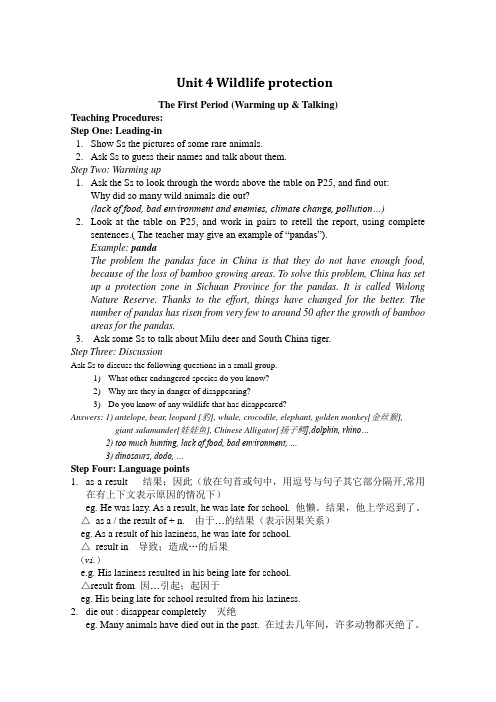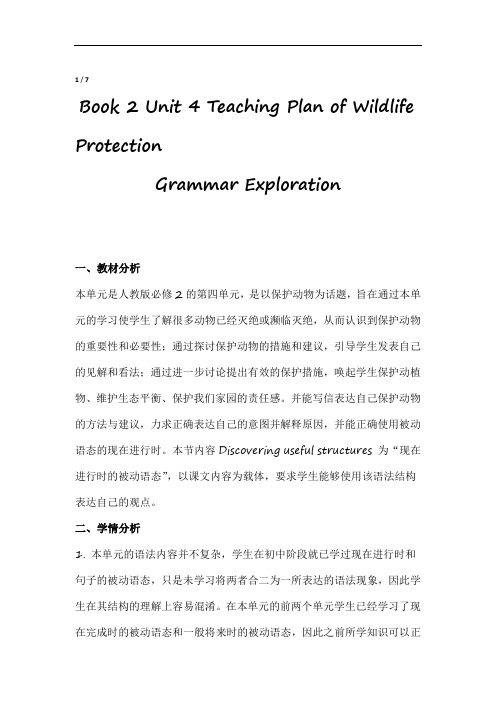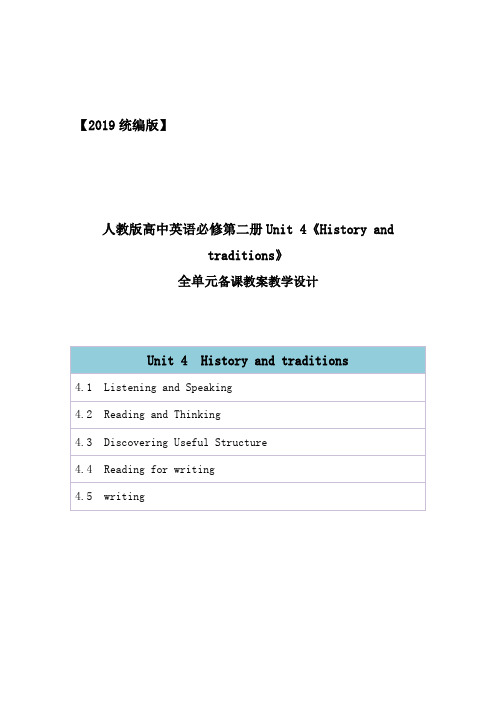人教版高中英语必修2第4单元教案
2020学年高中英语Unit4HistoryandTraditionsPeriodThree教案新人教版必修第二册

Period Three Discovering Useful Structures—Past participles(1) as the attribute and the object complement感知以下句子,完成方框下的小题1.Most people just use the shortened name:“the United Kingdom” or “the UK”.2.They use the same flag,known as the Union Jack,as well as share the same currencyand military defence.3.They had castles built all around England,and made changes to the legal system. 4.The peaceful landscape of the “Emerald Isle” and its many green counties is atrue feast for the eyes,with its rolling green hills dotted with sheep and cattle. 5.Judy and I had our car parked in an underground car park near Trafalgar Square,where we could get our car battery charged.6.When we finally reached the service desk to ask for audio guides,we heard it announced that there were no audio guides left.1.句1和2中加黑词汇在句中作定语。
高中英语人教版必修2Unit4单元教案正式版

Unit 4 Wildlife protectionThe First Period (Warming up & Talking)Teaching Procedures:Step One: Leading-in1.Show Ss the pictures of some rare animals.2.Ask Ss to guess their names and talk about them.Step Two: Warming up1.Ask the Ss to look through the words above the table on P25, and find out:Why did so many wild animals die out?(lack of food, bad environment and enemies, climate change, pollution…)2.Look at the table on P25, and work in pairs to retell the report, using completesentences.( The teac her may give an example of “pandas”).Example: pandaThe problem the pandas face in China is that they do not have enough food, because of the loss of bamboo growing areas. To solve this problem, China has set up a protection zone in Sichuan Province for the pandas. It is called Wolong Nature Reserve. Thanks to the effort, things have changed for the better. The number of pandas has risen from very few to around 50 after the growth of bamboo areas for the pandas.3. Ask some Ss to talk about Milu deer and South China tiger.Step Three: DiscussionAsk Ss to discuss the following questions in a small group.1)What other endangered species do you know?2)Why are they in danger of disappearing?3)Do you know of any wildlife that has disappeared?Answers: 1) antelope, bear, leopard [豹], whale, crocodile, elephant, golden monkey[金丝猴], giant salamander[娃娃鱼], Chinese Alligator[扬子鳄],dolphin, rhino…2) too much hunting, lack of food, bad environment, …3) dinosaurs, dodo, …Step Four: Language points1.as a result 结果;因此(放在句首或句中,用逗号与句子其它部分隔开,常用在有上下文表示原因的情况下)eg. He was lazy. As a result, he was late for school. 他懒。
高中英语 UNit 2 Working the land教案 新人教版必修4 教案

Unit 2words and expressions1.struggle Vi eg: The little boy struggled with the thief bravely.They had to struggle with/against all kinds of difficulties.She struggled to keep back the tears.He has been struggling for success in business.=He has been struggling to succeed in his business.为了事业的成功,他一直努力奋斗着。
n. eg: After a long struggle ,she gained control of the business.Her struggle with the disease lasted ten years.高考连接:The children talked so loudly at dinner table that I had to struggle ______.A to be heardB to have heardC hearingD being heard2.hunger n[U]eg: In those days ,many persons died of hunger .(死于饥饿)[C] 欲望,渴望eg: The child has a strong hunger for knowledge.强烈的求知欲The whole world has a hunger for peace.v. hunger to do sth. 渴望干某事 hunger for sth.渴望得到某物eg: The whole world hungers for peace.3.disturbing adj. disturb v. disturbedadj.eg: The news from the front is disturbing.The disturbing news soon got around the town.I am sorry to disturb you so early.They were all disturbed by the disturbing news ; that is ,the news disturbed all of them.S he was disturbed about her mother’s sudden illness.I felt disturbed to hear of your illness.4.expand eg:The eagle expanded his wings.He is thinking of expanding his business.Metals expand when they are heated .Our foreign trade has expanded greatly in recent years.In ten years ,the city’s population expanded by 10%.搭配expand …. in/into…..把….扩展. expand on/upon 详细阐明Eg: He expanded his short story into a novel.I don’t understand your reasoning. Can you expand on it?5.thanks to eg; Thanks to your timely help, I managed to finish the work on time.It was thanks to his advice that I succeeded.表示“原因”的介词短语还有:due to(一般不放于句首) ; as a result of ,because of ;owing to ; on account of; in that(引导原因状语从句)eg:The accident was due to his careless driving .Owing to your timely help, we finished the work ahead of time.As a result of the bad weather ,the football match was put off.His request is unreasonable in that he knows we can't afford it.We delayed our departure on account of the bad weather.6.rid……of eg:You should rid yourself of the bad habit.We try to rid the house of mice.拓展get/be rid of 摆脱;除掉eg:I can’t get rid of this headache.She was glad to be rid of him.:warn sb. of sth.; inform sb. of sth. ; cure sb. of sth. ; rob sb.of sth.;7.be satisfied with eg:I was satisfied/pleased/content with the result.be satisfied to do 对做某事感到满意eg: He was satisfied to win the race.拓展: Some people are hard to satisfy.(vt)There was a satisfied look on his face.(adj)The answer was quite satisfying /satisfactory to him.(adj.)To our satisfaction, he accepted our invitation.(n.)8 .would rather eg: I would rather play football this afternoon, if you don’t mind.I’d rather not let him know the truth.Would you rather stay here or go home?I would rather stay at home than go out. =I would stay at home rather than go out.would rather 后跟从句时,表示主语宁愿让某人做某事,从句用虚拟语气即用一般过去时表示与现在或将来事实相反;用过去完成时表示与过去事实相反。
高中英语必修二教案

高中英语必修二教案【篇一:人教新课标高一英语必修2_unit_1教案】unit 1cultural relicsi. 单元教学目标ii. 目标语言ii. 教材分析与教材重组1. 教材分析本单元以cultural relics为话题,旨在通过单元教学使学生了解世界文化遗产,学会描述它们的起源,发展和保护等方面的情况,复习并掌握定语从句,能就如何保护和处理世界文化遗产给出自己的观点。
1.1 warming up 热身部分提供了四幅图片,设计了三个问题让学生交流对于cultural relic的了解,并就此进行讨论。
这部分的目的是呈现本单元的中心话题“文化遗产”。
1.2 pre-reading 是reading的热身部分,提供了ambers的图片并就此此设计了两个问题。
这两个问题极易引起学生对amber的兴趣,并能引导学生对课文进行prediction。
1.3 reading是关于寻找丢失了的普鲁士国王威廉一世送给俄罗斯沙皇的那个琥珀房子的建立、转让、被毁、重建的整个历史。
设计这篇文章的目的是让学生了解什么是文化遗产以及讨论保护和重建文化从文化遗产的重要性和必要性。
1.4 comprehending既有知识性的问题,同时又跳出了课文,对文章进行整体评价,由易到难,有较好的梯度,全面考查学生对文章的理解。
exercise 1将人物及相关事件匹配,检验学生对文章细节的理解;exercise 2 将所给的问题与段落匹配,是段落大意理解题;exercise 3安排了对于重建lost cultural relics的意义进行讨论,使得学生能对本单元的主题进行较为深入的探讨。
1.5 learning about language 分discovering useful words and expressions 和discovering useful structures两部分。
其中第一部分的exercise 1着重训练对英语单词解释的理解。
高中英语必修第二册教案Unit 4 Information Technology—Viewing Workshop-北师大版(2019)

通过视听获取细节信息,并记录要点;从整体把握说话人的态度和立场,并通过讨论内化和应用语言。
能够说出两段视听材料中连接正反两方面论述主要观点的语言。
Step 5 Find out the “secret” ingredients
6) The market for printed books is dying.
获取视频中的基本观点。
学生能够说出视频中讲话人的立场和主要观点;学生能够完成活动2并筛选出正确信息。
2.表达关于纸质书是否将被电子书所取代的看法,并给出原因。
Step 3 Watch Part 1 again
1. With questions, watch Part 1 again.
2. Ss work in groups of four. Then copy the first five lines on the screen and discuss whether the speaker’s opinion changed when reading reversely.
通过小组分工合作交流及反复视听和操练,熟悉文章中出现的语言,从而更加清楚透彻地理解文章内容。
使语言学习从欣赏、发现,到学习、模拟,从而增强兴趣,提升英语素养。
学生能够创造性地仿写,体验语言学习的乐趣。
Unit 4 Information Technology
Viewing Workshop
教学目标
在本课结束时,学生能够:
1.获取两段视频谈论问题的基本观点;
2.表达关于纸质书是否将被电子书所取代的看法,并给出原因;
人教版必修2高中英语Unit4TeachingPlanofWildlifeProtection教案

1 / 7Book 2 Unit 4 Teaching Plan of Wildlife ProtectionGrammar Exploration一、教材分析本单元是人教版必修2的第四单元,是以保护动物为话题,旨在通过本单元的学习使学生了解很多动物已经灭绝或濒临灭绝,从而认识到保护动物的重要性和必要性;通过探讨保护动物的措施和建议,引导学生发表自己的见解和看法;通过进一步讨论提出有效的保护措施,唤起学生保护动植物、维护生态平衡、保护我们家园的责任感。
并能写信表达自己保护动物的方法与建议,力求正确表达自己的意图并解释原因,并能正确使用被动语态的现在进行时。
本节内容Discovering useful structures 为“现在进行时的被动语态”,以课文内容为载体,要求学生能够使用该语法结构表达自己的观点。
二、学情分析1. 本单元的语法内容并不复杂,学生在初中阶段就已学过现在进行时和句子的被动语态,只是未学习将两者合二为一所表达的语法现象,因此学生在其结构的理解上容易混淆。
在本单元的前两个单元学生已经学习了现在完成时的被动语态和一般将来时的被动语态,因此之前所学知识可以正迁移到新知识上来;2. 本班是一个中等水平的文科实验班,学生的学习习惯较好,课堂参与度较高,因此,学生能够通过小组探究学习的方式,探讨出要求掌握的语法结构,并且通过小组协作的方式,运用所学的语法结构编出短剧,以达到学以致用的目的与保护野生动物的情感共鸣。
三、教学思路本堂课共分为三个板块:热身,发现规则和运用规则三个板块,以一只藏羚羊的遭遇与诉求将这三个部分串联起来。
热身部分,通过呈现两组图片(每组图片间都相关联)和关键词,让学生描述图片所表达的现象,达到初步感知语法结构的目的;发现规则部分,首先,要求学生找出课文中所有含有“现在进行时的被动语态”结构的句子,并分析其基本结构(be being done),其次,阅读一封来自藏羚羊莹莹写给人类的信,让学生深入到语境中进一步探讨现在进行时的被动语态的各种结构,如:肯、否定句,一般、特殊疑问句及其用法和意义;运用规则部分,让学生以藏羚羊莹莹的身份编一个短剧(运用现在进行时的被动语态,现在完成时的被动语态和一般将来时的被动语态),以求达到学以致用、复习和保护野生动物的情感目标。
人教版高中英语必修二 Unit 4教案

教学内容一.Words1. affect v. 影响;侵袭,使感染 affection n. 喜爱;affected adj. 假装的;做作的;【拓展】be affected by被……侵袭;被……感动He was much affected by the sad news. 这个悲惨的消息使他非常难过。
辨析:effect与affecteffect用作名词时,意为“影响,效果”,常用于have an effect on结构中;用作动词时,表示“引起,使发生”。
affect用作动词,意为“影响”,常表示消极的影响。
用effect,affect的适当形式填空(1)New controls will e into effect next month.(2)Parents’ words and actions will affect children greatly.2. contain v. 包含,含有;容纳;控制,抑制 container n.容器;集装箱;货柜The stadium is big enough to contain 100 thousand audience. 这个体育场足够大能容纳10万名观众。
I could not contain my laughter. 我控制不住笑出了声。
This drink doesn’t contain any alcohol. 这种饮料不含任何酒精。
辨析:contain,include与holdcontain通常用来指某种容器中盛有某物,装有某物,还指某种物质中含有某成分或含有其他物质。
指作为组成部分而被“包含”或“容纳”在内。
include通常表示把某事物作为其中的一部分包含在内。
在句中常构成分词短语sth. included或including sth.。
hold通常指有能力容纳,相当于contain,seat。
The bottle contains olives. 瓶子里装着橄榄。
2019统编人教版高中英语必修第二册unit 4《History and traditions》全单元教案教学设计

【2019统编版】人教版高中英语必修第二册Unit 4《History andtraditions》全单元备课教案教学设计Unit 4 HISTORY AND TRADITIONSListening and Speaking【教学目标】1. 掌握本课的重要词汇与句式;2. 引导学生通过课内听力训练,提高听力技巧,锻炼听力水平。
【教学重难点】1. 本课时的重要词汇与句式;2. 引导学生通过课内听力训练,提高听力技巧,锻炼听力水平。
【教学过程】Step 1 Lead inLook at the photo on Page 37, and then get the Ss to ask and answer the questions.1. What do you know about the buildings in the photo?2. What traditions of that city/country do you know about?3. Why is it important to protect historic buildings and cultural traditions?Then have some Ss share their views on the questions.Step 2 Share views on historic sites1. Before listening, get the Ss to look at some photos of Qufu in Activity 1 on Page 38. And ask “What can you say about these places?”Get the Ss to discuss in groups, and then ask several volunteers to share their views with the class.2. Listen to a conversation between a British tourist and a Chinese student inFinally check the answers with the class.3. Listen again and decide whether these statements are true (T), false (F), or not mentioned (NM).(1) Listen and judge, and check the answers.1) Confucius said that learning without understanding leads to confusion.2) Xiao Kong is doing a research project on Confucius philosophy.3) As one of Confucius’ descendants, Xiao Kong’s name is recorded in the family tree.4) Dacheng Hall is the tallest building in Qufu.(2) Then go through the question as bellow, and choose the right answer.·Why do you think William said his hometown was similar to Qufu?A. There are famous halls in his hometown.B. There are no tall buildings in his hometown.C. Both places have a famous person who was born there.D. His hometown doesn’t allow other buildings to be more noticeable than the historic buildings.4. Activity 4(1) At first, go through the Understand idioms with the Ss.An idiom is an expression which means something different from the meaning of the individual words. Some idioms present an idea or paint a picture that gives a hint as to the meaning. Other idioms can only be understood from the context in which they appear.(2) Write down the English idioms that are used in the conversation. Explain their meanings and think about some Chinese equivalents.5. Discuss the questions in groups, and then get some Ss to share their answers.(1) What do you know about Confucius’ ideas on education? Think of two or three examples. What else do you know about Confucius and his philosophy?(2) Think about a historic site that you have visited, and give an introduction to its history and importance.Step 3 Pronunciation1. Read this part of the poem “If-” written by British poet Rudyard Kipling.Notice the linking sounds. Then mark the linking sounds after the modelIf you can make one heap of all your winningsAnd risk it on one turn of pitch-and-toss,And lose, and start again at your beginningsAnd never breathe a word about your loss;If you can force your heart and nerve and sinewTo serve your turn long after they are gone,And so hold on when there is nothing in youExcept the Will which says to them: "Hold on!"2. Repeat the poem after the recording.Step 4 Homework课后练习Unit 4 HISTORY AND TRADITIONSReading and Thinking【教学目标】1. 理解并熟练掌握本课的重要词汇与句式;2. 引导学生通过课内阅读,了解英国的历史,全面培养学生的阅读能力和技巧。
- 1、下载文档前请自行甄别文档内容的完整性,平台不提供额外的编辑、内容补充、找答案等附加服务。
- 2、"仅部分预览"的文档,不可在线预览部分如存在完整性等问题,可反馈申请退款(可完整预览的文档不适用该条件!)。
- 3、如文档侵犯您的权益,请联系客服反馈,我们会尽快为您处理(人工客服工作时间:9:00-18:30)。
教案设计一、教案背景1,面向学生:高中2,学科:英语2,课时:13,学生课前准备:(1)预习课文,了解有关野生动植物保护的内容(2)搜集一些和野生动植物保护的图片及保护野生动植物方法二、教学课题了解:通过这篇文章的学习,使学生了解目前野生动植物保护存在的问题,懂得保护野生动植物的方法及重要性。
掌握:课文中的重点短语,句型,语法三、教材分析本单元的中心话题是“保护野生动物”。
它是人们普遍关注、学生比较熟悉的话题。
这篇阅读课文How Daisy Learned To Protect Wildlife 是本单元的核心,它是一篇童话故事,讲述一个小女孩Daisy乘坐a flying carpet 跨越时空和藏羚羊、大象、猴子对话的神奇经历,展示了Daisy逐渐认识保护动物的重要性和必要性的过程。
文中动物们讲述了各自的处境,唤起了Daisy对动物的热爱以及保护动物的责任心。
通过阅读课,使学生更加热爱动物、保护动物,学会从我做起、从现在做起。
教学重点1. Develop students’ reading and speaking skills.2. Let students learn some important language points教学难点1. Enable students to learn to use reading strategies such as skimming, scanning, and so on.2. Have students make a discussion about wildlife protection.三维目标知识与技能目标1. Get students to learn some useful new words and expressions in this part.2. Get students to read the text.3. Let students learn some expressions and grammar.过程与方法目标1. Develop students’ reading skills and enable them to learn how to use different reading strategies to read different reading materials.2. Have students learn how to use the expressions and grammar.情感态度与价值观目标1.Let the students know the importance of wildlife protection and learn to protect them.2. Develop students’ sense of group cooperation and teamwork.四、教学方法1.自主学习:让学生课前预习,自主查找与本课时相关的内容。
2.合作探究:小组合作从网络上查找关于野生动植物的图片和资料,帮助他们熟悉话题以便于他们在学习过程中积极参与和主动探索。
3.结合多媒体技术,采用资源式、探究式的教学方法;注重交际活动,实施开放性讨论五、教学过程Step 1 Words preview1._______far away in space or time2. ___________to go down to a lower level3. _________to do something to make a change4. ________able to control events5. _________打猎,猎取,搜寻6. __________鉴赏,感激意识到7. ____________保护…不受…伤害8._________ 回答,响应Step 2 Leading-in1. Show a shot move about Wildlife Protection 成龙呼吁保护野生动物公益广告成龙呼吁保护野生动物公益广告(英语)- 视频- 优酷视频- 在线观看2. Have them in pairs discuss why they are endangered and show students some pictures.Step 3 Pre-readingShow students some information about wildlife protection from the Internet and ask students to discuss the following questions in pairs,1. What is wildlife protection about?2. What endangered species do you know?3. Why are they in danger of disappearing?Step 4 Fast reading1.Read the passage quickly, and finish the main idea .Daisy took _____________to travel and talked with ____________ in her dream, which made her know _____________ of the wildlife protection.2. Read quickly and silently, finish the true or false questions.(1).Daisy saw many antelopes in Tibet.(2).The elephant used to be well protected in Zimbabwe.(3).In Zimbabwe, tourists love to see the elephants.(4).This is a real story in Daisy’s life.Step 5 Careful reading1.Read aloud, and then match the main idea with each paragraph.Paragraph1 A Daisy decided to be the voice of the wild animalsParagraph2 B Elephants are being protected by the Zimbabwe government .Paragraph3 C Antelopes are likely to disappear altogether .Paragraph4 D The monkey is unhappy with the way humans are dealing with environment problems2. Try to find the important language points and finish the following important sentences(1). Daisy has always longed to help endangered species of wildlife. 译:_________________________________________________.(2). a. Our fur is being used to make sweaters for people like you.b. We used to be an endangered species. Farmers hunted uswithout mercy.be used to do:used to do:be/get/grow used to (doing) sth:_________________________他过去烟抽得很厉害.He heavily.(3). The flying carpet travelled very fast, and they arrived inZimbabwe just in a short while.(从原文中找句子替换)____________________________________________________________________________________________________________________Step 6 Discussion (Group work)What should we do to protect the endangered animals?Step 7 Fill in the retellingDaisy is a girl who longed to help___________ _______. One day, she woke up andfound _ _____ ______. Then she had a chance to see many animals with the help of the flyingfur __ ____ ____ carpet. First she went to see the_______. Daisy learned that antelope’s___make sweater, so the antelope becomes_________ ________ Daisy was sad, then shewent to see many elephants. They ___ ___ ___the endangered species, but now with the helpof government, the farmers began to protect them, so Daisy was very happy. Last Daisy wentto the _________, where she saw a monkey. And the monkey told Daisy “no rainforest, n ________,no ______”.Daisy was amazed. But anyhow, she had known the importance of protecting animals.Step 8.HomeworkWriting——More and more animals are killed by humans , as a student what should you do to protect the wild animals?六、教学反思这节课是一篇关于野生动物保护的阅读课,在让学生学习一些单词和短语的基础上,训练他们的阅读技巧,让他们懂得如何做好野生动物的保护工作。
